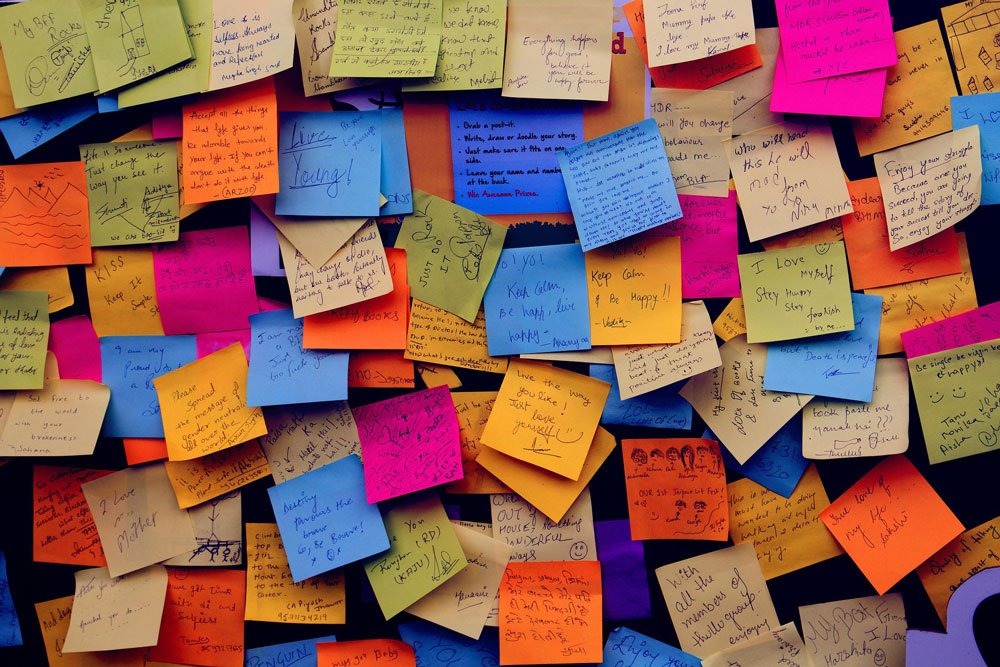What Do You Think About Having Notes When You Present?


We’ve published a few articles on presentation preparation, but we’ve never addressed the use of notes when presenting. It’s exactly the kind of issue that the Guru was set up to tackle. Should a presenter use notes? What will the audience think? What is the best kind of note? How should we use them? So many unanswered questions about such a small, but important element of the presenter’s life, especially for the less experienced speaker. Here, Amy gives us five simple but effective tips for using notes effectively, while maintaining a solid engagement with our audience.
“What do you think about having notes?”
We get this question a lot.
Can I have notes?
Where do I put them?
What should I put on them?
Are there do’s and don’ts?
These questions trigger flashbacks of high school when we got proficient in writing as tiny and as clear as possible because of the ‘one notecard’ policy for tests or speeches. Better yet, blowing on your hand for the ink to dry before go-time. Pretty early on in our presentation experiences we learned to rely on notes. Our sacred safety net.
There are a few reasons we did this then and we still do this now.
First, if you don’t know your content well, you will desperately want/need notes. That’s a lose-lose situation. Very few people feel comfortable winging content (disclaimer: if you do¸don’t be so sure you’re good at it). When you feel unsure of your content, you will be nose in your notes – which is audience’s number one pet peeve of presenters. You’re uncomfortable. They’re annoyed. Lose-lose.
Secondly, maybe you’ve worked hard on your content but feel immense pressure to get it just right. Maybe it’s a demanding executive with genius curve ball questions or the haunting memory of bombing the last (unpracticed) presentation. Regardless, the mounting pressure to perform can be paralyzing. This inevitably leads to dependency on notes, or better yet, a slide deck that reads like a teleprompter.
Once you become familiar with your content, try these tips for using notes appropriately.
1) Skip note cards
Note cards don’t work for two simple reasons: your text will be too small to glance at quickly (keyword quickly) and you have to hold them in your hands. If you’re feeling extra nervous, your hands will likely shake, waving those notecards around like a white surrender flag. Even if there’s no visible shaking, most people exhibit nervous behavior with their hands which may mean you start curling the card, moving it back and forth between hands etc. Pretty simple solution: print notes out on standard paper.
2) Put them to the side
Your notes should be placed where you can easily read or see them within a glance but not sitting on a podium in front of you. Podiums or speaking stands are bulky and keep you distant (literally) from your audience. Although many of us may find comfort hiding behind this blocking mechanism, there’s too much temptation to read your notes verbatim when they’re under your nose. Find a thin stand or pull over a small table to your left or right for your notes.
3) Make it an outline
Ditch your script. I know… some of you want to get the words just right. But when you script it word-for-word you put way too much pressure on yourself. It’s extremely difficult to be present, authentic and engaging as a presenter when you’re concerned about staying to the script. The minute you get off by a word or two, or God-forbid a sentence or paragraph, you feel the panic. Your heart rate spikes. You stumble over your words. And any perception of confidence and competency is lost. Stick to the essence of your ideas. Don’t be concerned about specific wording (unless it’s legal jargon and you might get sued!). Instead, make your notes in outline form: concise opening, clear main points, supportive points, story cues, transitions, succinct summary but keep your notes simple.
4) Make them bigger
Now that you haven’t scripted your talk, and they’re not below your nose or in your hands, you’ll need to make the font slightly larger. Now you can glance over, spot where you are, see what’s next, and truck along without those long awkward ‘oh no the speaker looks like they lost their spot’ moments. Increase the font!
5) Trust what you know
Ultimately, if you’ve prepared and own your content, you need to trust what you know. Lengthy notes, verbatim scripts, and strategically-placed teleprompters can make us doubt ourselves. I’ll never forget coaching a TEDx speaker who was glued to the teleprompter in her dry run. After a short pep talk about trusting what she knew, she did it again, unsure at first, but finding a confident stride as she realized she didn’t need her safety net much at all. It was liberating for her.
Let’s say you’re ready for your presentation, you know your stuff, but as soon as you hit your stride, you suddenly lose your train of thought.
How do you use your notes in these moments without looking like you’re desperate for them?
- Stop talking. Once you sense you’re on that rabbit trail to nowhere, find the control to stop at the end of a sentence.
- Grab for a water bottle strategically placed by your notes. Take a second to sip, glance down at your outline and identify what talking point you’re moving on to.
- As soon as you set your bottle down, shift away from your notes, re-engage with long eye contact and move on.
People won’t think twice about a presenter stopping a few seconds for water as long as you re-engage with confidence. The beauty of long eye contact is that it builds the perception of confidence even if you don’t feel it yet! Once you move on, don’t look back. Don’t relive those moments. Don’t dwell on them afterwards. Have grace with yourself and let it go.
Getting away from our safety net, one that we’ve learned to rely on since middle school, can feel terrifying. The next time you practice your presentation, try using your slides (that don’t look like a verbatim teleprompter!) as quick visual cues and see how much you can actually remember. If you need notes the first few tries that’s fine but rehearse a few more times. Develop trust in yourself.
Once you realize you really do know your stuff, your notes will become nice-to-haves and not must-haves.












John Zimmer
13th November 2016 at 7:45 pm
A good post about an issue that is relevant for many speakers, especially novice speakers. Many of the points that Amy raises dovetail with the points that I raised in a post on the same topic several years ago: https://mannerofspeaking.org/2009/08/05/a-noteworthy-idea/
I particularly appreciated her final point that speakers need to trust what they know. We see the same phenomenon with people who have cluttered PowerPoint slides. They get pulled into them. But if you turn the screen black, speakers will almost always be able to speak about the subject perfectly well without the slides.